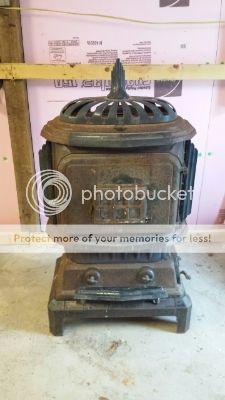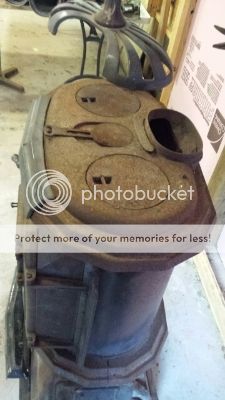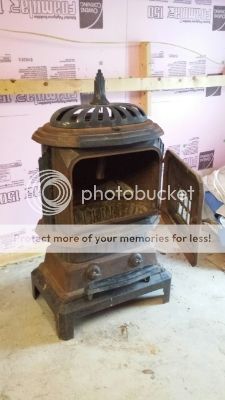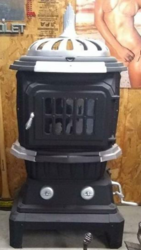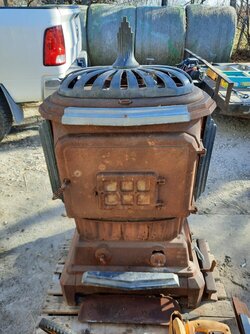Need info on this stove please.
- Thread starter steve75
- Start date
-
Active since 1995, Hearth.com is THE place on the internet for free information and advice about wood stoves, pellet stoves and other energy saving equipment.
We strive to provide opinions, articles, discussions and history related to Hearth Products and in a more general sense, energy issues.
We promote the EFFICIENT, RESPONSIBLE, CLEAN and SAFE use of all fuels, whether renewable or fossil.
You are using an out of date browser. It may not display this or other websites correctly.
You should upgrade or use an alternative browser.
You should upgrade or use an alternative browser.
It's a General something, made by Agricola Furnace Co. Guessing it's a coal parlor stove, estimated mfg. date 1925-1935?
Since there is no banking plate to keep coal pile away from door, I assume you only load to top of "basket". As you rotate the center plate does the handle adjust it open and closed very slightly? I don't see a secondary air inlet above the fuel bed, so I believe it's your air above fire to ignite coal gas. When fresh coal is heated, combustible gas is released and all air must come up through the coal bed to burn coal. Most of the oxygen is used up, so coal stoves have some sort of means of getting air to the top of the fire. This creates the blue flames above coal bed, adding heat. If you're burning wood, keep it closed or cracked since wood doesn't care where the air comes from. The more you open it, the less comes up through the bottom where coal requires it. Also the more you open it, the more inside air slips up chimney cooling the flue reducing draft. So it needs very little. Some European stoves use glass strips for the window with cracks between them for air - that's how very little it takes.
There may be numbers on the handle to show where you have it rotated. You would move it with poker when hot. It looks to be wide open straight forward.
With wood only, you could start it easily opening the under fire intakes and use the upper control once going too.
You remove one of the lids when in use to cook directly over fire. (air rushes into stove, it won't leak out unless bottom vents are open too far) They cook extremely fast this way, so you don't let food set long. Medium heat more like cooking on the lid, simmer is using a trivet to raise pots and pans. Regular cast iron pans are fine, or a wok sets in the hole great. Older pans will have a smoke ring around the bottom for a better seal. again, it won't smoke out, it will leak air in causing fire to burn harder, so pans or griddles that seal are best. This goes for all cook stoves with removable eyes. (lids)
There may be numbers on the handle to show where you have it rotated. You would move it with poker when hot. It looks to be wide open straight forward.
With wood only, you could start it easily opening the under fire intakes and use the upper control once going too.
You remove one of the lids when in use to cook directly over fire. (air rushes into stove, it won't leak out unless bottom vents are open too far) They cook extremely fast this way, so you don't let food set long. Medium heat more like cooking on the lid, simmer is using a trivet to raise pots and pans. Regular cast iron pans are fine, or a wok sets in the hole great. Older pans will have a smoke ring around the bottom for a better seal. again, it won't smoke out, it will leak air in causing fire to burn harder, so pans or griddles that seal are best. This goes for all cook stoves with removable eyes. (lids)
Last edited:
begreen, I'd say you're right on the age. This stove belonged to my great aunt and uncle. I got it to use in my shop.
coaly, I'll check that handle on the center plate and see if it adjusts. I know you can just take it off like the burner lids.
Thank you both for the info!! It's greatly appreciated! I can't wait to fire it up and see how it works.
coaly, I'll check that handle on the center plate and see if it adjusts. I know you can just take it off like the burner lids.
Thank you both for the info!! It's greatly appreciated! I can't wait to fire it up and see how it works.
Here's some history, an aerial view and past presidents. Gadsden Times Alabama;
http://news.google.com/newspapers?n...=emsnAAAAIBAJ&sjid=1NcEAAAAIBAJ&pg=1414,63395
Notice this company made many things for Montgomery Ward, so looking into their old catalogs you may find when it was available, cost and a description of what it was called. (parlor, utility, multi-fuel...... )
If rotating doesn't lift it slightly, I think you'll find you slide it forward and back to open and close. A mark or slot on the Finial (top cover) should show wear from movement if it was used correctly. Opening will make a wood fire burn harder. (used as primary air adjustment) Using the bottom air will burn your wood too fast - use them to kindle or coal. Opening the top a touch with a coal fire not only gives it secondary air, but at night you open it to allow inside air up chimney reducing draft, reducing what comes through the coal bed slowing fire. Otherwise many coal stoves would burn themselves out overnight. Tilting a lid overnight was another way to slow them down to assure a fire in the morning. A barometric damper does this automatically to control draft and would be advisable if used with coal.
http://news.google.com/newspapers?n...=emsnAAAAIBAJ&sjid=1NcEAAAAIBAJ&pg=1414,63395
Notice this company made many things for Montgomery Ward, so looking into their old catalogs you may find when it was available, cost and a description of what it was called. (parlor, utility, multi-fuel...... )
If rotating doesn't lift it slightly, I think you'll find you slide it forward and back to open and close. A mark or slot on the Finial (top cover) should show wear from movement if it was used correctly. Opening will make a wood fire burn harder. (used as primary air adjustment) Using the bottom air will burn your wood too fast - use them to kindle or coal. Opening the top a touch with a coal fire not only gives it secondary air, but at night you open it to allow inside air up chimney reducing draft, reducing what comes through the coal bed slowing fire. Otherwise many coal stoves would burn themselves out overnight. Tilting a lid overnight was another way to slow them down to assure a fire in the morning. A barometric damper does this automatically to control draft and would be advisable if used with coal.
Last edited:
Here's some history, an aerial view and past presidents. Gadsden Times Alabama;
http://news.google.com/newspapers?n...=emsnAAAAIBAJ&sjid=1NcEAAAAIBAJ&pg=1414,63395
Notice this company made many things for Montgomery Ward, so looking into their old catalogs you may find when it was available, cost and a description of what it was called. (parlor, utility, multi-fuel...... )
If rotating doesn't lift it slightly, I think you'll find you slide it forward and back to open and close. A mark or slot on the Finial (top cover) should show wear from movement if it was used correctly. Opening will make a wood fire burn harder. (used as primary air adjustment) Using the bottom air will burn your wood too fast - use them to kindle or coal. Opening the top a touch with a coal fire not only gives it secondary air, but at night you open it to allow inside air up chimney reducing draft, reducing what comes through the coal bed slowing fire. Otherwise many coal stoves would burn themselves out overnight. Tilting a lid overnight was another way to slow them down to assure a fire in the morning. A barometric damper does this automatically to control draft and would be advisable if used with coal.
I think you're right about it sliding forward and back to vent. I'm going to burn wood in it, so I'll use that to regulate the air? I have a question about where to install my damper. Do I just bend the stove pipe to fit in the "oval-shaped" top of the stove and put the damper in the section above that, or buy an adapter to go from the oval shape to fit the round pipe and put the damper above it? As you can tell, I'm no expert on these!!
Again, thank you for taking time to help me out!
Last edited:
Usually you can ovalize the pipe. I find Ace Hardware around here has the best assortment of oval to round adapters if you need one. The damper should be as close to the stove as possible within easy reach. A stove pipe thermometer on the pipe above damper gives you an idea of the flue gas temperature. The object is to keep the inside of chimney flue above 250* all the way to the top. Below that the water vapor that is a byproduct of combustion will condense in the flue causing smoke particles to stick. This is creosote formation, so you need to leave enough heat up to keep clean, yet not waste everything up the chimney. The larger the chimney flue cross sectional diameter the more heat required to stay above that critical temp. The hotter the flue stays inside by having the chimney inside the building, insulated liner....... the more efficient you can run any stove. The chimney flue should be the same size as stove outlet. No one can tell you where to run the damper since it slows the chimney when you need it. Outside temperature, low pressure areas moving over, chimney height and diameter, and in your case, leaks into the stove require different settings. Coal is much more critical of the air going through the firebed, so a barometric damper that constantly keeps the draft regulated is advised on most coal stoves.
Yes, the lever on top allows the higher air pressure in the house to push into the stove where it has a lower pressure area created by chimney. It becomes your throttle. (closing the damper takes away from the pressure differential that makes it work) Opening the bottom vents with wood will burn like crazy, but should be used for starting the fire before the chimney is drafting to prevent smoke from coming out of the intake. (have that closed when first lighting) That's why it may have marks on the handle giving you an idea how far it is pulled out so you know where the air is set. You can always file notches on the side of it if it's not marked so know what notch to set it for temperature desired.
Make sure the intake tube going down is not burned away or that it becomes too short. I see some with a 12 inch tube, so yours could have eroded away. Looks like that could be the wear point of the stove design.
Yes, the lever on top allows the higher air pressure in the house to push into the stove where it has a lower pressure area created by chimney. It becomes your throttle. (closing the damper takes away from the pressure differential that makes it work) Opening the bottom vents with wood will burn like crazy, but should be used for starting the fire before the chimney is drafting to prevent smoke from coming out of the intake. (have that closed when first lighting) That's why it may have marks on the handle giving you an idea how far it is pulled out so you know where the air is set. You can always file notches on the side of it if it's not marked so know what notch to set it for temperature desired.
Make sure the intake tube going down is not burned away or that it becomes too short. I see some with a 12 inch tube, so yours could have eroded away. Looks like that could be the wear point of the stove design.
Chimney pipe will be UL Listed meaning tested, and the testing facility gives them the clearance; That will be given on installation instructions. Most will have a kit made for through wall or through ceiling assuring proper clearance. Make sure it is Class A Chimney section. There is double wall connector pipe which is not chimney. What is the model of pipe and who is the manufacturer?
You need to make sure it's chimney first. It should be stainless steel inside, and if it only has an inner and outer wall, it will be heavy with dense insulation between the inner flue an outer pipe. There two types of chimney pipe. Double wall called "Pack" chimney and triple wall that will have a wrap of insulation between the inner flue and center pipe wall with an air space between second and outer pipe. Chimney sections normally twist lock together. Double wall connector pipe will be black. That is only for connecting appliance to chimney with reduced clearance of 6 inches instead of single wall pipe requiring 18 inches.
For a reference, Home Depot sells DuraVent which is the triple wall, (and has a larger outer diameter) and Lowe's sells Selkirk, which is the double wall pack type. That has a 2 inch clearance to combustibles, but you have to know what you've got unless someone can identify it with pictures here. Did it come with a box of some type that goes through the wall?
Or something that looks like this?
http://www.amazon.com/Selkirk-Metalbestos-6T-IWT-Stainless-Insulated/dp/B0009STIEC
Here's an idea of requirements (supports and components shown) from Selkirk;
http://www.selkirkcorp.com/installation-planners/premium_planner/support/Premium-Offset.pdf
For a reference, Home Depot sells DuraVent which is the triple wall, (and has a larger outer diameter) and Lowe's sells Selkirk, which is the double wall pack type. That has a 2 inch clearance to combustibles, but you have to know what you've got unless someone can identify it with pictures here. Did it come with a box of some type that goes through the wall?
Or something that looks like this?
http://www.amazon.com/Selkirk-Metalbestos-6T-IWT-Stainless-Insulated/dp/B0009STIEC
Here's an idea of requirements (supports and components shown) from Selkirk;
http://www.selkirkcorp.com/installation-planners/premium_planner/support/Premium-Offset.pdf
Last edited:
are there any markings or labels on it you really need to know what you have before installing itIt must be chimney because it twist locks together.
Yes, this could be older pipe that is not 2100 HT rated. See if there is any identifying mark or label on the pipe sections.
Chimney is infrastructure. Unless it can be ID'ed I would sell it and put in new class A chimney.
JRGomez
New Member
No coal stove will burn wood efficiently. They are designed to burn coal on a grate that gets lots of air up through the coal bed. A wood fire doesn't care where the air comes from and burns longer on a bed of ash. You want a stove lined with firebrick to increase the firebox temperature for a cleaner burn.
Micahgibler
New Member
Similar threads
- Replies
- 0
- Views
- 294
- Replies
- 2
- Views
- 665
- Replies
- 1
- Views
- 657
- Replies
- 0
- Views
- 223



